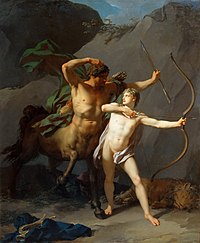|
Jean-Baptiste Regnault
  Jean-Baptiste Regnault (French pronunciation: [ʒɑ̃ batist ʁəɲo]; 9 October 1754 – 12 November 1829) was a French painter. BiographyRegnault was born in Paris, and began life at sea in a merchant vessel. At the age of fifteen his talent attracted attention, and he was sent to Italy by M. de Monval under the care of Jean Bardin. After his return to Paris in 1776, Regnault won the Prix de Rome for his painting Alexandre and Diogène and in 1783 he was elected to the French Académie des Beaux-Arts. His diploma picture, The Education of Achilles by Chiron the Centaur is now in the Louvre, as also are his Trois Grâces, Le Déluge, Descente de croix (Christ taken down from the Cross, originally executed for the royal chapel at Fontainebleau)[1] and Socrate arrachant Alcibiade du sein de la Volupté. His L'origine de la peinture and L'origine de la sculpture, ou Pygmalion amoureux de sa statue are now at the Palace of Versailles.[2] He was the author of many large historical paintings, especially of allegorical subjects. His school, which reckoned amongst its attendants Pierre-Narcisse Guérin, Louis-Philippe Crépin, Louis Lafitte, Merry-Joseph Blondel, Robert Lefèvre, Henriette Lorimier and Alexandre Menjaud, was for a long while the rival in influence of that of David.[1] Besides Blondel, Guérin, Lefèvre and Lorimier, Regnault's students included Godefroy Engelmann, Louis Hersent, Charles Paul Landon, Hippolyte Lecomte, Jacques Réattu, Jean-Hilaire Belloc and Anne Nicole Voullemier. Regnault was married first to Sophie Meyer, then Sophie Félicité Beaucourt. He died in Paris. He is buried in Père-Lachaise Cemetery.   Selected works
References
External linksWikimedia Commons has media related to Jean-Baptiste Regnault. |